|
IRANIAN EAGLES
Civil and Military Aviation in Iran 1924-1949
Part 2
© Lennart Andersson
|
 |
The IIAF and the Iranian Aircraft Factory
On March 22, 1935, the international name of the country was officially changed from Persia to Iran, and on October 1, 1935, the IIAF was reported to have on charge 51 Tiger Moths (33 Gipsy III and 18 Gipsy Major), 29 Hornet Audaxes and 28 Pegasus Audaxes, 20 Furies (Mercury), 10 R-5s (M-17), 2 Junkers W 33s (L 5), 11 R-1s (M-5, including five without engines) and the Curtiss Fledgling (Wright Whirlwind). A new batch of 20 Tiger Moths (c/ns 3290-3309) had been ordered and had arrived in January and February, and in May ten additional Tiger Moths (c/ns 3464-3473) were delivered. In the summer of 1936 new squadrons were established at Mashad and Ahvaz with a planned strength of 7 Audaxes, 7 Furies and 2 Tiger Moths each.
A contract for 25 Gloster Gladiator fighters with Mercury VI engines was apparently negotiated in the autumn of 1937. It was, however, never confirmed, or possibly placed and later cancelled. It was also rumoured that the Government had ordered twelve Junkers Ju 86K bombers after Ju 86 D-ALOH had been demonstrated in Tehran in October 1937. In November an Iranian aircraft deserted to the USSR. Apparently the crew was allowed to stay, but the aircraft was returned in January 1938.
In order to become self-sufficient, the Persian Government had decided to establish its own aircraft production facilities. The Iranian Aircraft Factory was erected at Shahbaz, Doshan Teppeh, 3.5 miles south-east of Tehran. The Swedish engineer N H Larsson had been engaged already in August 1933 to plan and organise the factory. Ten wood-workers, fitters and draftsmen started working in November 1935 and the necessary machinery was acquired. The factory was ready in 1936 and by October that year two British, one Italian and 41 Persians were on the payroll. A Captain Walker with Frank Knight as his assistant had replaced Larsson in the factory management. The first aircraft built were five Tiger Moths, which had been completed, but not yet tested, in October 1937. At the beginning of 1938 all five had been flown by the chief test pilot Captain Afghami. A batch of five Audaxes were completed during the spring of 1938.
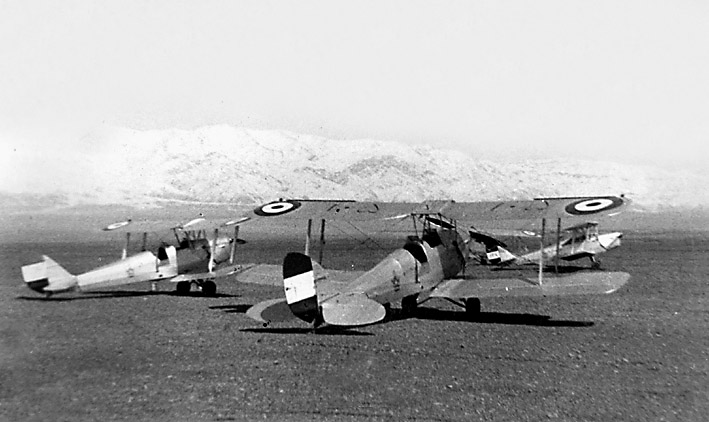
The Swedish advisers and instructors introduced the Tiger Moth and a total of almost 100 trainers of this type were acquired by the IIAF. Aircraft no 152 nearest to the camera.
The Shah inspected the factory on June 21, 1938, and was told that work was under way on new batches of five Audaxes and five Tiger Moths. At the end of the year the premises were expanded. The Tiger Moths were completed in March 1939 and the Audaxes were test flown and delivered in April-May the same year. In addition twenty British-built Tiger Moths (c/ns 3930-3934, 82005-82009, 82047-51 and 82092-96) arrived by rail to Tehran in June, to be assembled at the Iranian Aircraft Factory. The British personnel experienced co-operation problems with the Air Force authorities, and a campaign to suppress the use of Latin script in Iran made work difficult when store index cards and works orders had to be written solely in Persian.
Plans had been drawn up in 1934 for a military-run Iranian air service with five Fox Moth and five Dragon transports from de Havilland, but a smaller scheme was finally opted for. Three DH 89 Dragon Rapides (c/ns 6321-6323) were purchased in the following year. They arrived in July 1936 and were assembled by Peter de Havilland at Ahvaz. Five additional aircraft were ordered in the same month, but they were later cancelled. Three Persian pilots had been trained to fly the Dragon Rapide in England. They were to be operated in co-operation with the Ministry of Posts, Telegraphs and Telephones (PTT) and in March 1938 they were transferred from the IIAF to the Iranian State Airlines and were registered EP-AAA to AAC. This company had been established by the PTT with the assistance of Imperial Airways. Services from Tehran to Kermanshah and to Baghdad, Iraq, started on March 15, 1938. Several other places were later added to the domestic network. One aircraft crashed on March 20, 1939, and was burnt. Iran asked for a replacement in November 1939 and later placed an order, but was told that no Dragon Rapide was available.
In June 1938 the three squadrons of the 1st Regiment at Tehran had 15 Furies and 7 Tiger Moths, 15 Audaxes and 6 Tiger Moths, and 15 Audaxes and 7 Tiger Moths, respectively. The Flying Training School had 3 Furies, 8 Audaxes and 31 Tiger Moths. Detachments at Mashad and Ahvaz each had 7-8 Audaxes and 3 Tiger Moths. Further expansion of the IIAF was intended and an order had been placed in the previous year for 35 two-seat Hawker Hinds powered by the Bristol Mercury VIII. The first of these, s/n 601, made its first flight in April 1938. The first 18 arrived at Ahvaz in November and the last of the remaining 17 flew from Ahvaz to Tehran in February 1939. Another 20 Hinds were to be built at the Iranian Aircraft Factory and production of parts for the airframes started in February 1939. These aircraft were assembled and delivered in the spring of 1941.
In the summer of 1939 all formations were given status of Regiments:
1st Regiment at Qila Murgha (15 Furies, 26 Audaxes and 20 Tiger Moths)
2nd Regiment at Tabriz (10 Audaxes, 5 Tiger Moths)
3rd Regiment at Mashad (7 Audaxes and 3 Tiger Moths)
4th Regiment at Ahvaz, (10 Audaxes and 4 Tiger Moths)
In addition there was the Flying Training School at Mehrabad (3 Furies, 8 Audaxes, 35 Hinds and 51 Tiger Moths). The 5th Regiment was formed a little later at Doshan Teppeh, initially with 11 Tiger Moths.
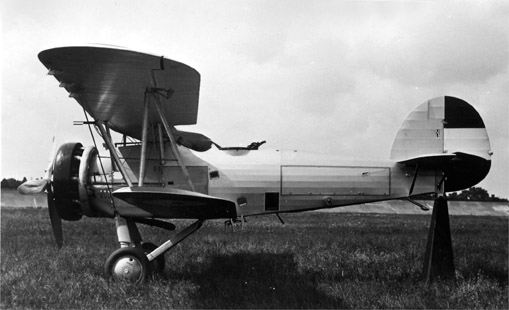
The Hawker Audax became the IIAF's main operational type in the mid-1930s. A total of 56 was delivered from Great Britain and the Iranian Aircraft Factory later built another ten.
Wedding Gifts and Hurricanes
On April 14, 1939, a Polish-built RWD-13 cabin monoplane (SP-BNY, c/n 285) piloted by Przysiecki and Krynski arrived in Tehran. It was a wedding gift to the crown prince from the Polish president and was later incorporated into the IIAF. The Iranian Government had made an inquiry about 24 Supermarine Spitfire fighters in November 1938, but as the order was not confirmed it was later cancelled. The Iranians also expressed interest in six Bristol Blenheims, and later in seven Handley Page Hampdens, but no order was placed for these types either. A contract was signed, however, for three Airspeed Oxford Mk Is (P1984, P1993 and P2002) in the autumn of 1939. They were delivered about March 1940 and were assembled and test flown by Airspeed test pilot Brian Field. In October 1940 a last batch of 10 Tiger Moths (c/ns 83352, 83353, 83355 and 83357-83363) was delivered from England. Iran intended to place an order in Canada for material for continued Tiger Moth production at the Iranian Aircraft Factory in 1941, but Great Britain rejected this request.
A Hawker Hurricane, L2079, was shipped to Iran for a six-month test on July 28, 1939. It arrived at Ahvaz and was flown to Tehran by Hawker test pilot Richard Reynell on 18 October. An order was placed for 30 Hurricanes with Merlin III engines, but the Air Ministry only agreed to release 15, to be despatched during the period March-September 1940. The contract for these was concluded in December 1939, but delivery was delayed by problems with the development of a tropical air filter. A second aircraft, P3270, was flown in Persian colours in Great Britain in May 1940 (s/n 252), but was probably never sent. The Air Ministry finally suspended the Hurricane order in December 1940.
When only half of the Hurricane order was released for delivery it was quickly decided to build the remaining 15 aircraft at the Iranian Aircraft Factory and raw material and finished parts were ordered in Great Britain early in 1941. For political reasons (strong German influence in Iran) the material needed for the Hurricane production was held up, however, in order not to strengthen the IIAF. In June it was decided to send material for 12 Hurricane Mk IIs with Merlin XX engines instead, with the first shipment due for immediate departure. The material was in fact released only in order to retain the British personnel still working at the Iranian Aircraft Factory - Technical Adviser Frank Knight and eleven other Englishmen. With political tension building up there were new delays and on August 25, the export licence for the material was withdrawn.
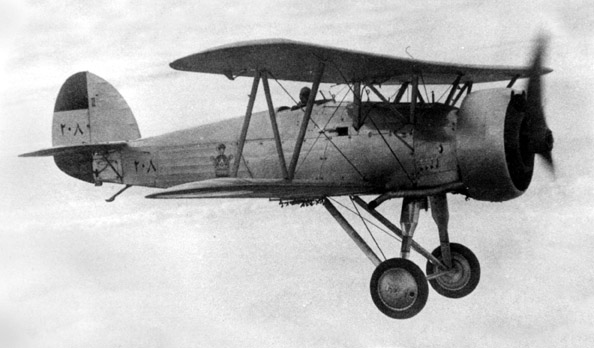
The standardised IIAF markings consisted of roundels on the wings, the Shah's crown emblem on the fuselage and the national colours on the rudder. The serial number was painted on the fuselage, on the rudder and under the wings. Hawker Fury no 208 in the air.
IIAF Order of Battle, November 20,1939
Qila Murgha: 33 Hind, 21 Fury, 1 Audax used for target-towing, 15 Tiger Moth, 1 Hurricane (without machine guns)
Mashad: 8 Audax, 4 Fury, 4 Tiger Moth
Tabriz: 21 Audax, 4 Tiger Moth
Ahvaz: 7 Audax, 4 Tiger Moth
Mehrabad Flying School: 38 Tiger Moth, 2 Hind (dual control), 9 Audax (dual control), 3 Fury
Under overhaul: 10 Audax, 7 Tiger Moth, 2 Fury
When the British refused to deliver, Iran turned to the USA instead. In November 1939 an IIAF mission, consisting of lieutenant colonel Khosrovani, major Shaltshi and captain Afghami left for the United States. They purchased ten Curtiss H-75A-9 Hawk fighters (c/ns 15252-12261), which were accepted in the USA between March 9 and April 8, 1941. One was shipped in March and the remainder in May. Test pilot Sam Irwin was sent out to make the delivery. The mission also ordered a number of light aircraft for the state-owned Iranian Aero Club (see later!). In the meantime the IIAF continued to train new pilots. On February 22, 1941, a total of 104 Tiger Moths, Hinds, Furies and Audaxes participated in a fly past during a military review.
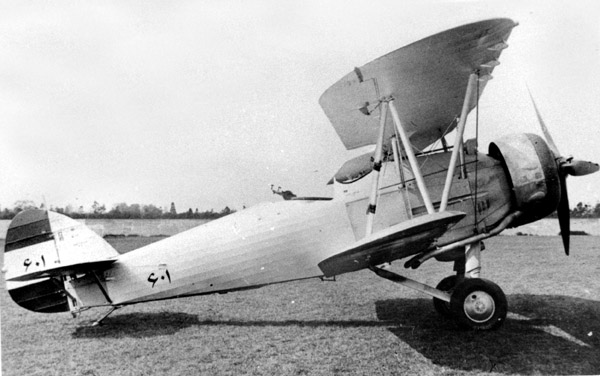
The first of 35 Hawker Hinds, no 601, arrived in the autumn of 1938. The local aircraft factory later completed a batch of twenty more.
World War Two
Traditional Iranian dislike of Great Britain made any political alliance with that country impossible. Germany had increased its influence in Iran, but this power was also viewed with suspicion. Neutrality was the only acceptable policy, something that was in fact encouraged by Germany. With the Germans advancing through the southern parts of the USSR against the Caucasus, the Allies considered the strong German presence in Iran unacceptable. On August 17, 1941, the USSR and Great Britain demanded the expulsion of German personnel working in Iran. This was rejected and as a consequence Iran was invaded on August 25. British troops entered the country from the south and the west, and the Russians arrived from the north.
Following the conclusion of British operations in Iraq in May 1941, plans had been drawn up for an operation against Iran. The British Commander-in Chief, Middle East, ordered an occupation of the oilfields around Abadan and Ahvaz and at Khanikin. Control of communications throughout Iran was to be established in co-operation with the USSR. The whole operation was code-named Operation 'Y' and was to be led by Lt Gen E P Quinan. Participating RAF aircraft were based at Shaibah and included 11 and 84 Squadrons with Blenheim IVs, 261 Squadron with Hurricanes and Gladiators, 244 Squadron with Vincents and 'A' Flight of 31 Squadron with six Valentia transports. The Valentias flew in troops and evacuated British and Indian women and children on the first day of the operation. The Royal Navy also landed troops. 261 Squadron provided fighter support and strafed the airfield and the IIAF Audaxes at Ahvaz. 84 Sq made two bombing attacks and 244 Squadron flew reconnaissance sorties.
On the following day 261 Squadron shot down an IIAF Audax. They also attacked and shot down one of their own, a Vincent from 244 Squadron! On August 28, 84 Squadron continued to attack Ahvaz, but on this day the Iranian troops surrendered and further offensive action was halted. On September 17 the Anglo-Russian forces moved into Tehran. A month later, after the Shah had abdicated in favour of his son, the British withdrew to Sultanabad and Hamadan, and the Russians to Kazirin and Pahlavi. 244 Sq, including 'X' Flight made up of the Gladiators from 261 Squadron, remained at Abadan as the air component of the British occupation forces until late 1942.
The Russian forces were composed of the 44th and 47th Armies (Trans-Caucasian Military District) and the 53th Detached Army. Air units included the 36th and 265th IAP (Fighter Air Regiment) with Polikarpov I-16 fighters. According to Iranian reports Tabriz, Mashad, Ardebil, Rasht and Bender-Pahlavi were bombed, but Russian records mention only reconnaissance and leaflet dropping sorties. When Tabriz was taken on August 28 the Russians captured all the aircraft belonging to the 2nd IIAF Regiment. The RAF was reported to have destroyed a total of five IIAF aircraft and another in a hangar that was set on fire during the attacks. The ten Curtiss H75A-9s were captured still unassembled by the British forces. At least three were assembled and flown at Tehran, one as HK823, and all were later shipped to India. They were taken over by the RAF as Mohawk IVs and nine received serials in the LA-range.
The Aircraft Factory ceased production after the invasion and No 138 Maintenance and Repair Unit, RAF, was later housed on the premises. Mines and aircraft parts were produced there, but IIAF aircraft were also serviced and repaired. Iran was forced to let the Allies use Iranian communications for the transit of war supplies to the USSR. A large number of mostly US-built Lend-Lease aircraft were assembled at Abadan, where a plant was built for the purpose, and sent to the USSR during the period 1942-45. A-20s, B-25s, P-39s, P-40s, P-47s and AT-6s passed through Iran, the last ones being three P-47D Thunderbolts handed over to the Russians in February 1945.

Iran acquired ten Curtiss H-75A-9 Hawk fighters from the USA.
Two Tiger Moths and two Audaxes were used by the RAF FTS at Doshan Teppeh on loan but the IIAF was also allowed to resume flying again. New aircraft were needed. The remaining eight Polikarpov R-5s used by the FTS were retired in 1943. A personal offer made by Stalin at the Tehran Conference in December 1942 for the delivery of 20 Ilyushin Il-2s and 10 Yakovlev Yak-7 fighters for free was politely refused for political reasons.
A declaration of war on Germany in September 1943, and the decision by the Allies in November the same year to recognise Iranian assistance and give economic aid, opened the way for deliveries of new aircraft. An allotment of at least 10 Oxford twin-engine trainers was discussed as a compensation for the Mohawks taken in 1941, but it was finally decided to supply 15 ex-RAF Avro Ansons instead (Almost certainly NK405, NK406, NK419, NK422, NK423, NK452-454, NK457, NK458, NK510-512, NK515 and NK516). They were shipped in May-June 1944 and were assigned to the 1st Bomber Regiment at Doshan Teppeh.
IIAF Order of Battle, December 1943
Regiment at Esfahan: 16 Hind (of which 8 were with a Detached Flight at Shiraz) and 7 Tiger Moth
Regiment at Tehran: 10 Audax, 27 Hind, 11 Fury and 18 Tiger Moth
Flying Training School, Tehran: 15 Audax, 1 Fury and 39 Tiger Moth
Independent Group: 3 Oxfords, 1 Hurricane, 1 Praga, 1 Curtiss Fledgling, 1 RWD-13 (apparently still registered SP-BNY!), 2 Junkers (probably W 33s) and 1 Dragon Rapide (Employed by the PTT/Iranian State Air Lines)
Aircraft Park and Maintenance Unit, Tehran: 11 Audax, 6 Hind, 4 Fury and 14 Tiger Moth
Civil Aviation
A Praga E.114 Air Baby was bought by a private person in Iran before the war and was taken over by the IIAF at some time before December 1943. It was later given to the Aero Club of Iran by the IIAF. This Government-run organisation negotiated without result for Miles Magisters and other types in Great Britain early in 1940 and then turned to the USA, where the Iranian mission ordered 25 Rearwin 8125 Cloudsters. The Cloudster was a two-seat high-wing cabin monoplane. Major Afghami, was to oversee production and personally fly each aircraft before delivery. They were shipped between October 1940 and January 1941 and were registered EP-ABF to EP-ACD (c/ns 841-865, tie-ups not known).
The Aero Club enjoyed a Government subsidy for training pilots for the IIAF and offered free training for qualified citizens. The wooden crates the Cloudsters were shipped in were designed so that they could easily be converted into barracks after arrival. Harry B Taylor accompanied the aircraft to Tehran and was contracted by the Government from 1941 until February 1945 for instruction and maintenance of the Aero Club's aircraft. It has been reported that a machine gun was mounted to the left wing strut of at least one aircraft, presumably for training purposes. All 25 Rearwins were still in service by 1945.
One of the Iranian State Airlines' Dragon Rapides had crashed in 1939 and the replacement ordered was never delivered. All civil flying was strictly controlled after 1941 and it seems that the RAF allocated serial numbers HK915, 916 and 917 to the Iranian Dragon Rapides. The remaining pair was reduced to a single example after a crash landing in April 1943. In August 1944 three ex-RAF DH 89 Dominies, HG707, HG710 and HG711 (c/ns 6692, 6695 and 6696), were delivered to Iran. They were all eventually added to the diminutive fleet of the State Airlines, which was reconstructed as the Skerkat Shami Havapeimace Iran, and were registered EP-AAD, 'E and 'T. The Iranian Airways Company was founded in December 1944 by a group of Iranian investors. G.H. Ebtehaj led the company, which was launched without government subsidy. Iranian Airways started a limited service between Tehran and Mashad on May 31, 1945 and later began to co-operate with Trans World Airlines (TWA).
During the war, France, Great Britain, the USA and the USSR operated semi-military services to Tehran. Aeroflot used Li-2s (DC-3s), and from January 1945 C-47s, on the route Tehran-Moscow. They also operated (without Iranian permit) between Tehran and Tabriz, Pahlavi and Mashad. BOAC operated a Tehran-Cairo service until September 1945 and Air France flew twice a month between Tehran and Paris. Pan American started a Cairo-Habbaniya-Basra-Tehran service in June 1942 and the USAAF operated a non-scheduled service to Tehran until September 1945.
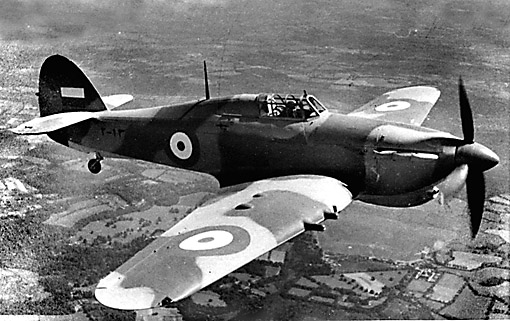
New equipment arrived in 1946-47 in the form of a large number of Hurricane Mk IICs. This is no 2-13.
The Imperial Iranian Air Force after the War
During the night of September 18, 1945, the Russians handed Qila Murgha airfield back to Iranian control. They did, however, continue to use a portion of the field and three hangars for their airline until they moved to Mehrabad at the end of 1945. The airfield at Mehrabad was handed over by the RAF on October 15, and became the civil airport of Tehran, although it remained under military control. A punitive expedition against the Kurds was carried out by the IIAF late in 1945 and a small detachment of Ansons and Hinds was sent to Kermanshah for army co-operation duties. The Ansons proved ineffective in the mountainous country where the operations took place, but the Hinds were used for dive bombing and strafing. The operational part of the air force now consisted of the Bomber Regiment at Qila Murgha with Ansons and the Reconnaissance Regiment at Doshan Teppeh with Hinds and Audaxes.
New equipment arrived in 1946-47 in the form of a large number of Hurricane Mk IICs, including a pair of two-seat trainers, and in 1949 the IIAF started receiving American aircraft. Deliveries under an American Arms Credit Program would finally include 60 Republic P-47 Thunderbolt fighters, seven Douglas C-47 Skytrain transports, 36 Piper L-4 Cub liaison aircraft, and 15 Stearman PT-13D Kaydet and 30 North American AT-6D Texan trainers. Fifteen of the P-47s were to be cannibalised for use as spares.
Iranian pilots started training on the P-47 in West Germany in the autumn of 1948. The seven C-47s were delivered first, however, and arrived about 1 April 1949. The P-47s followed in the autumn of 1949. The American aid included technical assistance and 24 Iranian students were given pilot training by American instructors. A number of IIAF personnel were sent to Great Britain for technical training as well.
Early in 1950 the Bomber Squadron at Isfahan, which had previously operated Ansons, had no aircraft. At Qila Murgha were two Fighter Regiments, one with 30 Hurricanes and two two-seat Hurricane Trainers, the other with 56 P-47 Thunderbolts. Reconnaissance Squadrons No 1 and 2 had 25 Hinds, seven Audaxes, 12 Tiger Moths and two Ansons at Doshan Teppeh, Tabriz, Meshed, Ahwaz, Shiraz and Isfahan. The Transport Squadron had seven C-47s. The Pilot Training School, finally, had 17 Tiger Moths, five Ansons, and four Audaxes. In addition there were (out of service) 17 Tiger Moths, 15 Audaxes, seven Hinds, five Ansons, three P-47s, two Oxfords and two Hurricanes, and 36 L-4s had arrived but had not yet been assembled. The 15 PT-13Ds and 30 AT-6Ds were still on order.
Although the old long-serving Hawker Audaxes, Hinds and Furies were retained for some time as trainers, the arrival of American aircraft marked the end of an era for the IIAF.
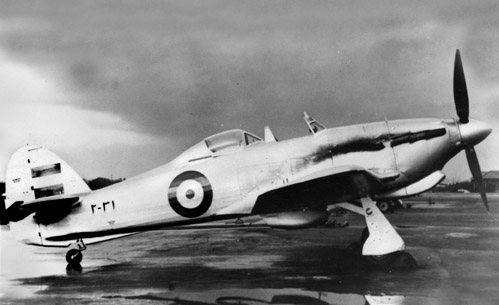
Two-seat Hawker Hurricane Trainer no 2-31.
IIAF serial numbers
|
10-11
|
Junkers
W 33
|
|
12-(24)
|
R-1
|
|
30-39
|
Polikarpov R-5
|
|
101-199
|
Tiger Moth
|
|
201-224
|
Hawker
Fury
|
|
251-252
|
Hawker
Hurricane
|
|
252-(261)
|
Curtiss
H-75
|
|
401-461
|
Hawker
Audax
|
|
601-655
|
Hawker
Hind
|
|
801-803
|
Airspeed
Oxford
|
IIAF Aircraft 1922-1945
|
Type
|
Qty
|
First delivered
|
Remarks
|
|
Unknown
|
1
|
1922
|
Captured (Russian)
|
|
Breguet 14
|
2-3
|
1924
|
|
|
Potez VIII
|
2
|
1924
|
|
|
Spad 42
|
2
|
1924
|
|
|
R-1 (DH.9A)
|
24
|
1924
|
|
|
Junkers
F 13
|
3
|
1924
|
|
|
U-1
(Avro 504K)
|
9
|
1924
|
|
|
Junkers A 20
|
2
|
1925
|
|
|
R-2 (DH 9)
|
3
|
1926
|
|
|
Breguet 19
|
2
|
1926
|
|
|
Junkers W 33
|
2
|
1929
|
|
|
DH 82 Tiger Moth
|
109
|
1932
|
10 IAF-built
|
|
Polikarpov
R-5
|
10
|
1933
|
|
|
Hawker
Audax
|
66
|
1934
|
10 IAF-built
|
|
Curtiss Fledgling
|
1
|
1934
|
|
|
Hawker Fury
|
24
|
1934
|
|
|
DH 89 Dragon Rapide
|
3
|
1936
|
|
|
Hawker Hind
|
55
|
1938
|
20 IAF-built
|
|
RWD-13
|
1
|
1939
|
|
|
Hawker Hurricane
|
1
|
1939
|
(30 ordered)
|
|
Airspeed Oxford
|
3
|
1940
|
|
|
Curtiss H75A Hawk
|
10
|
1941
|
|
|
Praga E.114 Air Baby
|
1
|
194?
|
|
|
Avro Anson
|
15
|
1944
|
|
The Author would like to thank John Havers, Roger Jackson, Lennart Johnsson and Ray Sturtivant for their kind assistance during the preparation of this article.
|
|
|
|





